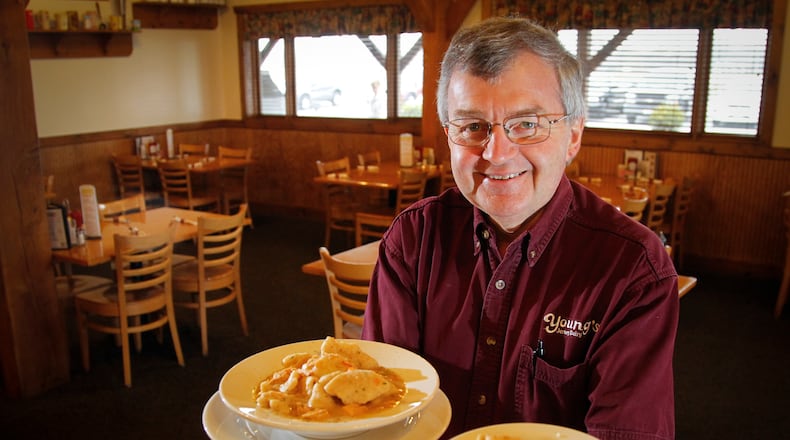By the numbers
- Up 8.9 percent: Rise in servings at restaurants that added more lower-calorie items.
- Down 16.3 percent: Drop in servings by restaurants that offered fewer lower-calorie items.
- Up 10 percent: Rise in total sales at restaurants that added more lower-calorie items.
- Down 3.8 percent: Drop in total sales at restaurants that offered fewer lower-calorie items.
Study covered 21 national restaurant chains between 2006 and 2011. Lower calorie means 500 or fewer calories for a “center of the plate” item, such as a sandwich; 150 or fewer calories for a side dish; 50 or fewer calories for an 8-ounce beverage; 150 or fewer calories for an appetizer; and 150 or fewer calories for a dessert item.
Source: Hudson Institute
Restaurant chains analyzed: Applebee's, Arby's, Burger King, Carrabba's, Chili's, Cracker Barrel, Denny's, IHOP, Wendy's, Longhorn Steakhouse, Romano's Macaroni Grill, Outback Steakhouse, On The Border Mexican Grill, Panera Bread, Olive Garden, Taco Bell, McDonald's, Red Lobster, KFC, Chick-fil-A, Sonic
Restaurants across the country are discovering that incorporating more low-calorie items into restaurant menus isn’t just the healthy thing to do — it’s also good business.
That’s the conclusion of a new study released last week by the Hudson Institute that shows that low-calorie options are beginning to pay off in restaurants’ bottom lines.
The findings have big implications for the $660 billion U.S. restaurant industry and the nation’s fight against obesity. The medical cost of adult obesity is an estimated $147 billion a year, according to the study.
Dan Young knew he was doing the right thing from a health perspective last year when he introduced a slimmed-down 5-ounce version of his restaurant’s popular 10-ounce Top Sirloin dinner.
But he wasn’t sure how his customers at the Golden Jersey Inn in Clark County would react — after all, the price break wasn’t all that significant, with the 10-ounce steak dinner that remained on the menu selling for $15.95 and the new 5-ounce option costing $12.50.
But customers embraced the lighter version enthusiastically: within months, “the five-ounce option started selling better” than the steak that is twice its size, Young said.
Whether the rather sudden embrace of lower-calorie fare is the result of a new level of health awareness prompted by calorie-count boards posted in America’s chain restaurants — or simply diners’ reluctance to spend money — is open to debate. “I think it’s about fifty-fifty,” Young said. Either way, restaurants are taking notice, and now they have the Hudson Institute’s analysis to accelerate the trend.
“Until now, there has been little evidence regarding how restaurant chains can do well by doing good,” the institute’s report said. But after gathering five years’ worth of data on restaurant servings, customer traffic and sales data on menu items of 21 of the nation’s largest restaurant chains such as McDonald’s, Panera Bread and Red Lobster, the Hudson Institute concluded that those restaurants that added lower-calorie food and beverage options to their menus “demonstrated superior same-store sales growth, increases in restaurant customer traffic (and) gains in overall restaurant servings.”
Boosting the selection of low-calorie items “can help quick-service and sit-down restaurant chains improve the key performance metrics demanded by their shareholders and Wall Street, while at the same time providing lower-calorie foods and beverages for families and children,” the report said.
Shanon Morgan, president of the Miami Valley Restaurant Association, said she has seen both chains and independently owned restaurants in Southwest Ohio offering more lower-calorie or healthier options. And independent restaurants are increasingly willing to modify a dish at customers’ request, Morgan said.
“I’m also seeing more small-plate options offered in local restaurants,” Morgan said. “Is this because of pricing, or is it because of health concerns? I’m not sure, but it seems to be working well for restaurants, and I think it’s here to stay.”
That’s welcome news to Rich Cohen, registered dietitian with Kettering Health Network’s Kettering Weight Loss Solutions.
“It’s great news for a country that suffers an epidemic of obesity,” Cohen said. “I think we have a very creative and responsive restaurant industry, and the realization that people want, and will pay for, lower-calorie choices will spur the industry on to be more creative. This is a win-win for those seeking to enjoy healthier eating in a restaurant experience and the food establishments wishing to improve their business.”
Panera Bread — which operates restaurants in Hamilton, Fairfield, West Chester, Springfield and multiple Dayton-area locations — was an early adopter of calorie-count boards that list nutritional content of its menu items.
The chain has added lower-fat menu items, tweaked existing menu items and changed service habits in response to customers’ desire for healthier fare, according to Judy Ketner-Dollison, vice president of marketing for Breads of the World, which operates 31 Panera Bread franchise locations in Southwest Ohio and elsewhere in the state and another 31 locations in Colorado.
The calorie-count panel prompted Panera to re-examine its entire menu with an eye toward reducing calories and fat where possible, Ketler-Dollison said. The chain switched to a lower-fat mayonnaise, unveiled a spinach salad option that has become quite popular and stopped automatically putting calorie-adding condiments on sandwiches without customer request, Ketner-Dollison said. The chain also just announced it will roll out nationwide a number of low-carb options that it calls a “hidden menu” which initially was available only in the New York City area.
Panera’s financial results are impressive, and the chain is growing. Its comparable same-store sales jumped 5 percent in the fourth quarter of 2012, its stock price has gone up 300 percent in five years, and it added 123 new bakery-cafes across the country in 2012 and expects to add a similar number in 2013.
Ketler-Dollison acknowledged that Panera, like other restaurants, has to walk a careful line between calories and taste to avoid alienating customers. “We do have a commitment to not sacrifice the flavor” of its dishes, she said.
The owner of the Golden Jersey Inn agreed. As the head of the family that operates Young’s Family Dairy, Dan Young is not about to abandon ice cream for, say, non-dairy frozen yogurt.
But he also knows that 15 years ago, the most common order at Young’s Dairy was for a double-dip ice cream cone. Today, by a wide margin, the most frequently ordered menu item is a single-dip cone.
About the Author

